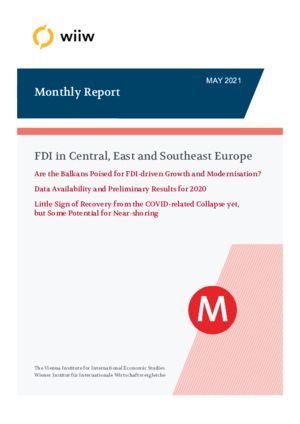Monthly Report No. 5/2021 - FDI in Central, East and Southeast Europe
Vasily Astrov, Alexandra Bykova and Olga Pindyuk
wiiw Monthly Report No. 5, May 2021
52 pages including 5 Tables and 34 Figures
This issue of the wiiw Monthly Report replaces our earlier series of the wiiw FDI Report.
FDI in Central, East and Southeast Europe
- Chart of the month: Are the Balkans poised for FDI-driven growth and modernisation?
by Vasily Astrov
- Data availability and preliminary results for 2020
by Alexandra Bykova
Last year, the inflow of FDI into CESEE was the weakest in a decade, and its profitability fell by 2 percentage points, to 7% on average. Slovakia and Ukraine both recorded negative FDI inflows, while Estonia maintained its leading position in per capita terms. Preliminary FDI data for 2020 are available from the most recent update of the wiiw FDI Database; this is the first of two FDI data releases planned for this year.
- Little sign of recovery from the COVID-related collapse yet, but some potential for near-shoring
by Olga Pindyuk
After a sharp decline last year, the prospects for recovery of FDI inflows to CESEE in 2021 are poor in most sectors, apart from ICT and energy. This is signalled by the decline in the number of greenfield projects announced in the last quarter of 2020. So far, the COVID-19 pandemic has had little effect on re-shoring and near-shoring.
- Monthly and quarterly statistics for Central, East and Southeast Europe
Reference to wiiw databases: wiiw Annual Database, wiiw Monthly Database, wiiw FDI Database
Keywords: FDI inflows, FDI stocks, FDI profitability, FDI by instrument of financing, FDI methodology, greenfield FDI, supply chain disruptions, near-shoring, producer-related business services
Countries covered: CESEE, Balkan States, Central Europe
Research Areas: International Trade, Competitiveness and FDI
